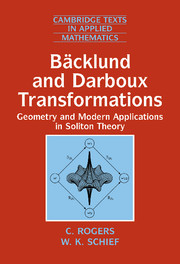Book contents
- Frontmatter
- Contents
- Preface
- Acknowledgements
- General Introduction and Outline
- 1 Pseudospherical Surfaces and the Classical Bäcklund Transformation. The Bianchi System
- 2 The Motion of Curves and Surfaces. Soliton Connections
- 3 Tzitzeica Surfaces. Conjugate Nets and the Toda Lattice Scheme
- 4 Hasimoto Surfaces and the Nonlinear Schrödinger Equation. Geometry and Associated Soliton Equations
- 5 Isothermic Surfaces. The Calapso and Zoomeron Equations
- 6 General Aspects of Soliton Surfaces. Role of Gauge and Reciprocal Transformations
- 7 Bäcklund Transformation and Darboux Matrix Connections
- 8 Bianchi and Ernst Systems. Bäcklund Transformations and Permutability Theorems
- 9 Projective-Minimal and Isothermal-Asymptotic Surfaces
- Appendix A The su(2)–so(3) Isomorphism
- Appendix B CC-Ideals
- Appendix C Biographies
- Bibliography and Author Index
- Subject Index
1 - Pseudospherical Surfaces and the Classical Bäcklund Transformation. The Bianchi System
Published online by Cambridge University Press: 04 March 2010
- Frontmatter
- Contents
- Preface
- Acknowledgements
- General Introduction and Outline
- 1 Pseudospherical Surfaces and the Classical Bäcklund Transformation. The Bianchi System
- 2 The Motion of Curves and Surfaces. Soliton Connections
- 3 Tzitzeica Surfaces. Conjugate Nets and the Toda Lattice Scheme
- 4 Hasimoto Surfaces and the Nonlinear Schrödinger Equation. Geometry and Associated Soliton Equations
- 5 Isothermic Surfaces. The Calapso and Zoomeron Equations
- 6 General Aspects of Soliton Surfaces. Role of Gauge and Reciprocal Transformations
- 7 Bäcklund Transformation and Darboux Matrix Connections
- 8 Bianchi and Ernst Systems. Bäcklund Transformations and Permutability Theorems
- 9 Projective-Minimal and Isothermal-Asymptotic Surfaces
- Appendix A The su(2)–so(3) Isomorphism
- Appendix B CC-Ideals
- Appendix C Biographies
- Bibliography and Author Index
- Subject Index
Summary
The explicit study of surfaces of constant negative total curvature goes back to the work of Minding in 1838. Thus, in that year, Minding's theorem established the important result that all such surfaces are isometric, that is, they can be placed in one-to-one correspondence in such a way that the metric is preserved. Beltrami subsequently gave the term pseudospherical to these surfaces and made important connections with Lobachevski's non-Euclidean geometry.
It was Bour, in 1862, who seems to have first set down what is now termed the sine-Gordon equation arising out of the compatibility conditions for the Gauss equations for pseudospherical surfaces expressed in asymptotic coordinates.
In 1879, Bianchi in his habilitation thesis presented, in mathematical terms, a geometric construction for pseudospherical surfaces with the same total curvature. This result was extended by Bä in 1883 to incorporate a key parameter which allows the iterative construction of such pseudospherical surfaces. The Bäacklund transformation was subsequently shown by Bianchi, in 1885, to be associated with an elegant invariance of the sine-Gordon equation. This invariance has become known as the Bäacklund transformation for the sine-Gordon equation. It includes an earlier parameter-independent result of Darboux. The Bäacklund transformation has important applications in soliton theory. Indeed, it proves that the property of invariance, under Bäacklund and associated Darboux transformations as originated in, is enjoyed by all soliton equations.
- Type
- Chapter
- Information
- Bäcklund and Darboux TransformationsGeometry and Modern Applications in Soliton Theory, pp. 17 - 59Publisher: Cambridge University PressPrint publication year: 2002

